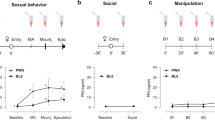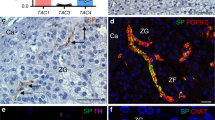Abstract
THE secretion of prolactin, a pituitary hormone, is regulated by inhibitory and stimulatory influences from the hypothalamus. The primary influence is tonic inhibitory1. Dopamine, a neurotransmitter, has a major direct and/or indirect role in mediating this inhibition upon the prolactin cells in the pituitary gland. This is documented by studies in vitro1, in vivo2 and in man3. All known neuroleptic, antischizophrenic drugs share one characteristic—they block dopaminergic transmission4–7. This action is hypothesised to be associated with their antischizophrenic effects (dopamine hypothesis)3,9. Dopaminergic blockade is, very likely, also the primary mechanism of neuroleptics when inducing prolactin release via disinhibition1,10. There is no evidence that neuroleptics release prolactin via stimulatory influences. We believe the prolactin response to neuroleptic drugs to be a valid and reliable model of dopaminergic blockade in man (Langer et al., unpublished). Intesting the dopamine hypothesis of antischizophrenic drug action in man we postulated that comparing drug effects after acute intramuscular administration, a high correlation between prolactin releasing and antischizophrenic potencies of neuroleptics would be found.
This is a preview of subscription content, access via your institution
Access options
Subscribe to this journal
Receive 51 print issues and online access
$199.00 per year
only $3.90 per issue
Buy this article
- Purchase on Springer Link
- Instant access to full article PDF
Prices may be subject to local taxes which are calculated during checkout
Similar content being viewed by others
References
MacLeod, R. M. in Frontiers of Neuroendocrinology (eds Martini, L. & Ganong, W. F.) 169–194 (Raven, New York, 1976).
Lu, K. H. & Meites, J. Endocrinology 91, 868–872 (1972).
Leblanc, H., Lachelin, G. C. L., Abu-Fadil, S. & Yen, S. S. C. J. clin. Endocr. Metab. 43, 668–674 (1976).
Van Rossum, J. M. Archs. Int. Pharmacodyn. Thér. 160, 492–501 (1966).
Horn, A. S. & Snyder, S. H. Proc. natn. Acad. Sci. U.S.A. 68, 2325–2329 (1971).
Miller, R. J. & Iversen, L. L. J. pharm. Pharmac. 26, 142–147 (1974).
Clement-Cormier, Y. C., Kebabian, J. W., Petzold, G. L. & Greengard, P. Proc. natn. Acad. Sci. U.S.A. 71, 1113–1117 (1974).
Kety, S. S. & Matthysse, S. Neurosci. Res. Prog. Bull. 10, 370–394 (1972).
Snyder, S. H., Banerjee, S. P., Yamamura, H. I. & Greenberg, D. Science 184, 1243–1253 (1974).
Diefenbach, W. P., Carmel, P. W., Frantz, A. G. & Ferin, M. J. clin. endocr. Metab. 43, 638–642 (1976).
Hwang, P., Guyda, H. & Friesen, H. Proc. natn. Acad. Sci. U.S.A. 68, 1902–1906 (1971).
Byck, R. in The Pharmacological Basis of Therapeutics (eds Goodman, L. S. & Gilman, A.) 152–200 (Macmillan, New York, 1975).
Davis, J. M. J. psychiat. Res. 11, 65–69 (1974).
Stevens, J. R. Archs gen. Psychiat. 29, 177–189 (1973).
Author information
Authors and Affiliations
Rights and permissions
About this article
Cite this article
LANGER, G., SACHAR, E., GRUEN, P. et al. Human prolactin responses to neuroleptic drugs correlate with antischizophrenic potency. Nature 266, 639–640 (1977). https://doi.org/10.1038/266639a0
Received:
Accepted:
Issue Date:
DOI: https://doi.org/10.1038/266639a0
This article is cited by
-
Neuere Antipsychotika
Der Nervenarzt (2007)
-
The atypical antipsychotics olanzapine and quetiapine, but not haloperidol, reduce ACTH and cortisol secretion in healthy subjects
Psychopharmacology (2006)
-
Neuroendocrine profile of SDZ HDC-912 and OPC-4392, two new atypical antipsychotic drugs, in schizophrenic patients
Psychopharmacology (1993)
-
Pharmacokinetics of haloperidol and fluphenazine decanoates in chronic schizophrenia
Psychopharmacology (1990)
Comments
By submitting a comment you agree to abide by our Terms and Community Guidelines. If you find something abusive or that does not comply with our terms or guidelines please flag it as inappropriate.



